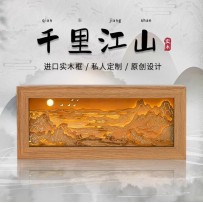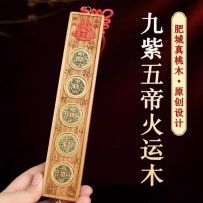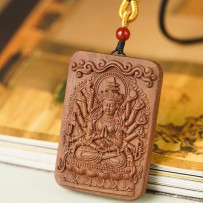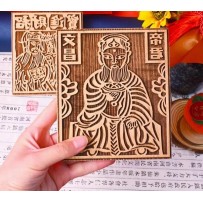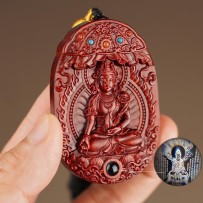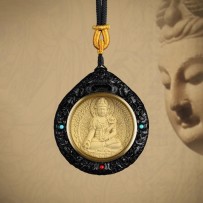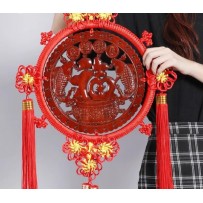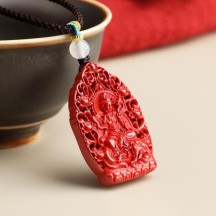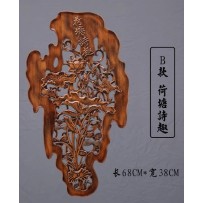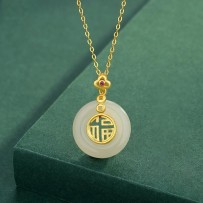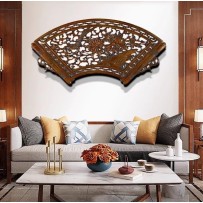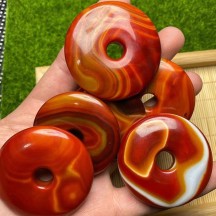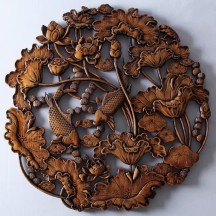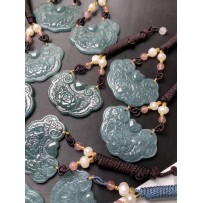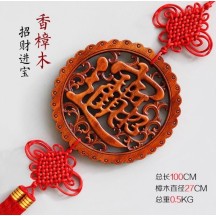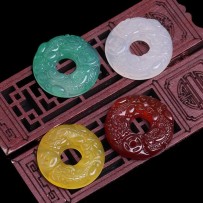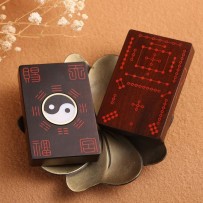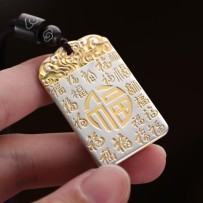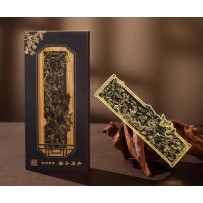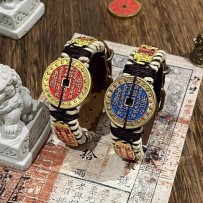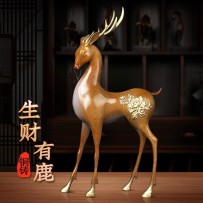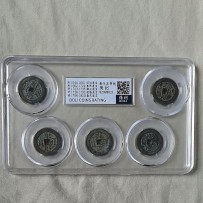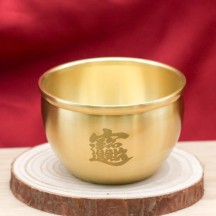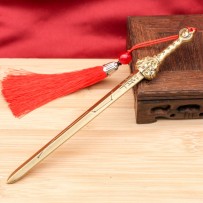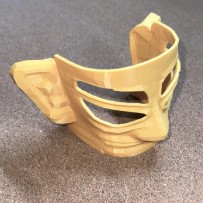Design inspiration: Mainly derived from the silk painting "A Thousand Miles of Rivers and Mountains" by Wang Ximeng of the Northern Song Dynasty. This renowned painting, with its grand scenes, delicate brushstrokes and brilliant colors, depicts continuous mountains, vast rivers, lush forests and scattered pavilions and terraces, presenting the magnificence and beauty of the mountains and rivers during the Northern Song Dynasty. The 3D stereoscopic light and shadow wood Carving lamp of "Thousand Miles of Rivers and Mountains" is based on this model. It aims to recreate the landscape artistic conception in paintings through the forms of wood carving and light and shadow, allowing people to appreciate the charm of ancient art in modern life.
Subcategories
The idea of the guardian deity of the zodiac is that according to the ten heavenly stems and twelve earthly branches, the causal relationships of the 12 zodiac signs, and the mutual generation of the five elements of "earth, water, fire, wind, and space", the 12 zodiac signs are blessed by eight Buddhas and Bodhisattvas.
It is figuratively called the "birth Buddha", which is the guardian deity of the zodiac.
Buddha and Bodhisattva not only have a heart of compassion to save the world, but also a heart of enlightenment and awakening to others, protecting all living beings.
The Nine Purple Li Fire Cycle: It is a concept in numerology. Ancient people divided 20 years into one cycle, and the period from 2024 to 2043 belongs to the Lower Yuan Nine Cycles. The nine cycles correspond to the Li hexagram in the I Ching's Eight Trigrams and are called the "Nine Purple Li Fire Cycle". During this period, all the phenomena of all things that conform to the element of Li Fire will emerge accordingly.The Five Emperors' Coins: Usually composed of copper coins cast by the five emperors of the prosperous Qing Dynasty, namely Shunzhi, Kangxi, Yongzheng, Qianlong and Jiaqing, they carry the energy of prosperity and are unique cultural symbols. In feng shui theory, they have the effects of promoting wealth, warding off evil energy and praying for good fortune.
The idea of the guardian deity of the zodiac is that according to the ten heavenly stems and twelve earthly branches, the causal relationships of the 12 zodiac signs, and the mutual generation of the five elements of "earth, water, fire, wind, and space", the 12 zodiac signs are blessed by eight Buddhas and Bodhisattvas.
It is figuratively called the "birth Buddha", which is the guardian deity of the zodiac.
Buddha and Bodhisattva not only have a heart of compassion to save the world, but also a heart of enlightenment and awakening to others, protecting all living beings.
Jia Ma, also known as "paper horse" or "divine paper", is an ancient and mysterious folk woodblock print used in folk sacrificial activities to pray for blessings and eliminate disasters. It is popular throughout Yunnan Province. Among them, the Bai ethnic group's Jia Ma is the most distinctive. It is a kind of woodcut work that still exists among the common people in the primitive witchcraft and etiquette of the Bai ethnic group.It is a comprehensive reflection of Dali woodcarving techniques, printing techniques and papermaking techniques on primitive religious sacrificial items. It is a precious cultural heritage and has been included in the third batch of intangible cultural heritage list of Dali Prefecture.
The idea of the guardian deity of the zodiac is that according to the ten heavenly stems and twelve earthly branches, the causal relationships of the 12 zodiac signs, and the mutual generation of the five elements of "earth, water, fire, wind, and space", the 12 zodiac signs are blessed by eight Buddhas and Bodhisattvas.
It is figuratively called the "birth Buddha", which is the guardian deity of the zodiac.
Buddha and Bodhisattva not only have a heart of compassion to save the world, but also a heart of enlightenment and awakening to others, protecting all living beings.
Dongyang woodcarving is renowned for its exquisite carving craftsmanship. Artisans employ a variety of carving techniques, such as relief carving, through carving, and round carving, to vividly present various patterns on camphor wood boards. The lines are smooth and the layers are distinct, demonstrating an extremely high artistic standard.
The idea of the guardian deity of the zodiac is that according to the ten heavenly stems and twelve earthly branches, the causal relationships of the 12 zodiac signs, and the mutual generation of the five elements of "earth, water, fire, wind, and space", the 12 zodiac signs are blessed by eight Buddhas and Bodhisattvas.
It is figuratively called the "birth Buddha", which is the guardian deity of the zodiac.
Buddha and Bodhisattva not only have a heart of compassion to save the world, but also a heart of enlightenment and awakening to others, protecting all living beings.
The Chinese knot symbolizes unity, beauty, happiness and peace, and has meanings such as reunion, completeness and good fortune. Dongyang woodcarving has a long history. The patterns carved on it often contain rich cultural significance, endowing the pendants and ornaments with a deeper cultural background and expressing people's yearning for a better life.
The idea of the guardian deity of the zodiac is that according to the ten heavenly stems and twelve earthly branches, the causal relationships of the 12 zodiac signs, and the mutual generation of the five elements of "earth, water, fire, wind, and space", the 12 zodiac signs are blessed by eight Buddhas and Bodhisattvas.
It is figuratively called the "birth Buddha", which is the guardian deity of the zodiac.
Buddha and Bodhisattva not only have a heart of compassion to save the world, but also a heart of enlightenment and awakening to others, protecting all living beings.
Dongyang woodcarving mainly features flat relief, and is characterized by multi-layered relief and scattered perspective composition. Carvers employ techniques such as thin relief, low relief, deep relief, high relief, and multi-layer layering to create works that are rich in layers yet dynamic, with smooth and natural lines, enabling them to vividly present various patterns on camphor wood.
Ping An Kou is a traditional Chinese jade ornament. It is round and flexible in appearance, which conforms to the "doctrine of the mean" in traditional Chinese culture. In ancient times, it was called "Bi" and has the effect of nourishing the body. In modern times, it is often given to lovers, relatives, and friends as a gift to wish for peace.
Dongyang woodcarving mainly features flat relief, and is characterized by multi-layered relief and scattered perspective composition. Carvers employ techniques such as thin relief, low relief, deep relief, high relief, and multi-layer layering to create works that are rich in layers yet dynamic, with smooth and natural lines, enabling them to vividly present various patterns on camphor wood.
Ping An Kou is a traditional Chinese jade ornament. It is round and flexible in appearance, which conforms to the "doctrine of the mean" in traditional Chinese culture. In ancient times, it was called "Bi" and has the effect of nourishing the body. In modern times, it is often given to lovers, relatives, and friends as a gift to wish for peace.
Dongyang woodcarving mainly features flat relief, and is characterized by multi-layered relief and scattered perspective composition. Carvers employ techniques such as thin relief, low relief, deep relief, high relief, and multi-layer layering to create works that are rich in layers yet dynamic, with smooth and natural lines, enabling them to vividly present various patterns on camphor wood.
The patterns on jade pendants are extremely delicate and varied, and through the patterns, we can understand the rich cultural connotations, production techniques, and social and economic environment of the time.
Dongyang woodcarving mainly features flat relief, and is characterized by multi-layered relief and scattered perspective composition. Carvers employ techniques such as thin relief, low relief, deep relief, high relief, and multi-layer layering to create works that are rich in layers yet dynamic, with smooth and natural lines, enabling them to vividly present various patterns on camphor wood.
Ping An Kou is a traditional Chinese jade ornament. It is round and flexible in appearance, which conforms to the "doctrine of the mean" in traditional Chinese culture. In ancient times, it was called "Bi" and has the effect of nourishing the body. In modern times, it is often given to lovers, relatives, and friends as a gift to wish for peace.
Dongyang woodcarving mainly features flat relief, and is characterized by multi-layered relief and scattered perspective composition. Carvers employ techniques such as thin relief, low relief, deep relief, high relief, and multi-layer layering to create works that are rich in layers yet dynamic, with smooth and natural lines, enabling them to vividly present various patterns on camphor wood.
The Hetu and Luoshu are two mysterious patterns handed down from ancient China. They contain profound principles of the universe and astrology and are known as the "Magic Cube of the Universe". They are the source of Chinese culture, Yin-Yang and the Five Elements. The phrase comes from the Book of Changes, "The Hetu and the Luoshu". He refers to the Yellow River. Luo refers to the Luo River.
Dongyang woodcarving mainly features flat relief, and is characterized by multi-layered relief and scattered perspective composition. Carvers employ techniques such as thin relief, low relief, deep relief, high relief, and multi-layer layering to create works that are rich in layers yet dynamic, with smooth and natural lines, enabling them to vividly present various patterns on camphor wood.
The Peaceful and Trouble-free plaque is a type of jade pendant. Because the entire jade plaque is not carved, there is a saying in the jade industry that things without any carvings are called "nothing", so the jade plaque borrows the meaning of "peaceful and trouble-free". "Peaceful and Trouble-free" means peace and everything goes well.
The talisman money is a Taoist prayer object. These coins are cast with patterns of the Eight Diagrams, immortals, Taishang Laojun, and the God of Thunder. The mountain ghost flower money is a carrier used by Taoist priests in the Qing Dynasty to cast spells to subdue demons and exorcise ghosts. It can also be called a magic tool. After being consecrated by Taoist priests, people are requested to hang it in their homes or carry it with them to ensure safety.
Deer are noble, elegant, gentle and mysterious animals with upright postures.They are a good choice for displaying at home or giving as gifts.
The Five Emperors' Coins refer to five round copper coins with square holes, which symbolize the power of the five elements and the five directions, and have the function of warding off evil spirits and bringing good fortune. The saying that the five emperors minted coins is mostly fabricated by later generations. People call the coins issued by several dynasties the Great Five Emperors' Coins. The Great Five Emperors' Coins are made of bronze, including the Qin Banliang, the Han Wuzhu, the Tang Kaiyuan Tongbao, the Song Yuan Tongbao, and the Ming Yongle Tongbao.
Because of its legendary meaning of attracting wealth and its function of receiving money, the cornucopia is listed as an important Feng Shui ornament for attracting wealth, along with the "golden toad" and "lucky cat". In China, especially among the Han people in the south of the Yangtze River, the cornucopia is a treasure for guarding the house.
The early forms of ancient coins were mainly shellfish. In China, from the late primitive society to the Xia, Shang and Zhou dynasties, the main form of currency was physical currency, and the most widely circulated was natural shellfish. Later, a small amount of metal weighing currency and coins appeared.
Since ancient times, Taoists have used the "QiXing Sword" as a magical instrument for rituals, and even as a treasure to guard their sects. At that time, Buddhism and Taoism were both powerful, and both advocated the rise of martial arts. Therefore, Buddhism and Taoism greatly promoted the vigorous development of Chinese martial arts.
Sanxingdui culture can be traced back to the Xia and Shang dynasties, about 3,000 to 5,000 years ago.
The unearthed masks, especially the "bulging-eyed bronze statue" (also known as the "bronze man mask") with abnormally protruding eyeballs, show the uniqueness and mystery of the ancient Shu civilization
Based on the appearance of the Sanxingdui bronze man mask, this 3D printed model basically reproduces the details and unique shape of the original mask.
It cannot be guaranteed to be completely consistent with the unearthed original, so it is only used as a display of space ornaments such as office desks, entertainment and leisure, and national style displays.










